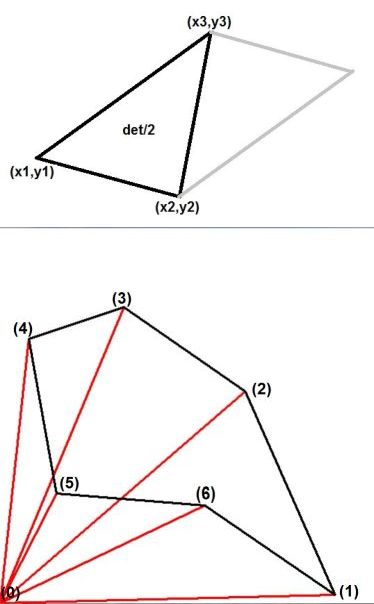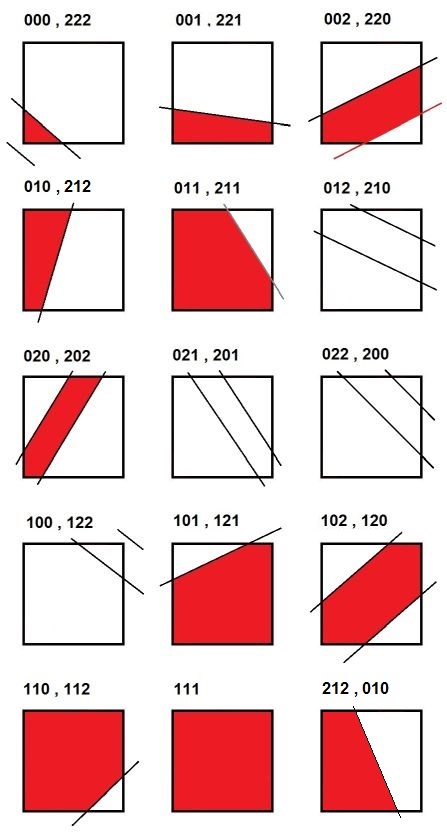

Area of polygon. Though at the moment we have only an impression of what
the polygons look like, the areas of them have to be calculated, in the end.

So it's useful anyway to have a general method for doing just that. What we can do
is to draw ($\color{red}{red}$) lines from the origin $(0)$ to the vertices of
the polygon (six in our case) and sum up the areas of the (six) triangles $(0,1,2),(0,2,3),(0,3,4),(0,4,5),(0,5,6),(0,6,1)$ : see figure
at the bottom. The figure at the top shows how the area of just one triangle is
calculated, by using a determinant:
$$
\mbox{area}\,\Delta =
\frac{1}{2} det\begin{bmatrix}(x_2-x_1) & (y_2-y_1)\\(x_3-x_1) & (y_3-y_1)\end{bmatrix}
$$
Note that, in general, the triangle areas thus calculated can be positive as well
as negative. And the latter is essential.
To be continued for the coordinates of the polygons, in anti-clockwise order.
Clipping problem. Usually a polygon (strip) is clipped against the square. But in our case, the square is clipped against a strip. Once the ideas are clear, the algebra involved is very elementary. Hoping that the program below is more or less self-documentary:
program Q901259;But: is it possible to have a solution without all the sub case jazz? The answer is affirmative; that's how I actually tested the correctness of the above program. Any area can be simply determined by pixel counting (not necessarily in a "real" picture). Advantage: quick and dirty. Disadvantage: less exact than the sub case method.
type point = record x,y : double; end; polygon = array of point;
function Area(round : polygon) : double; { Area of polygon } var k,L : integer; Det,Opp : double; p,q : point; begin Opp := 0; L := Length(round); if L > 0 then begin q := round[L-1]; for k := 0 to L-1 do begin p := q; q := round[k]; Det := (p.x*q.y - q.x*p.y); Opp := Opp + Det; end; end; Area := Opp/2; end;
function let(x,y : double) : point; var P : point; begin P.x := x; P.y := y; let := P; end;
function x_is_0(c,p : double) : point; begin x_is_0 := let(0,c/sin(p)); end;
function x_is_1(c,p : double) : point; begin x_is_1 := let(1,(c-cos(p))/sin(p)); end;
function y_is_0(c,p : double) : point; begin y_is_0 := let(c/cos(p),0); end;
function y_is_1(c,p : double) : point; begin y_is_1 := let((c-sin(p))/cos(p),1); end;
function Calculate(p,c : double) : double; { Calculate area of strip inside square x*cos(p) + y*sin(p) = +/- c : strip } const choice : array[0..26] of integer = (0,1,2,3,4,-1,5,-1,-1,-1,6,7,8,9 ,8,7,6,-1,-1,-1,5,-1,4,10,2,1,0); var k,number,digit : integer; x,y : double; poly : polygon; begin SetLength(poly,1); poly[0] := let(0,0); number := 0;
{Ternary number system } for k := 2 downto 0 do begin x := (k+1) mod 2; y := (k+1) div 2; digit := 1; if cos(p)*x+sin(p)*y < -c then digit := 0; if cos(p)*x+sin(p)*y > +c then digit := 2; number := number*3 + digit; end;
{All sub cases } case choice[number] of 0 : begin SetLength(poly,3); poly\[1] := y_is_0(+c,p); poly\[2] := x_is_0(+c,p); end; 1 : begin SetLength(poly,4); poly\[1] := let(1,0); poly\[2] := x_is_1(+c,p); poly\[3] := x_is_0(+c,p); end; 2 : begin SetLength(poly,5); poly\[1] := y_is_0(-c,p); poly\[2] := x_is_1(-c,p); poly\[3] := x_is_1(+c,p); poly\[4] := x_is_0(+c,p); end; 3 : begin SetLength(poly,4); poly\[1] := y_is_0(-c,p); poly\[2] := y_is_1(-c,p); poly\[3] := let(0,1); end; 4 : begin SetLength(poly,5); poly\[1] := let(1,0); poly\[2] := x_is_1(+c,p); poly\[3] := y_is_1(+c,p); poly\[4] := let(0,1); end; 5 : begin SetLength(poly,5); poly\[1] := y_is_0(-c,p); poly\[2] := y_is_1(-c,p); poly\[3] := y_is_1(+c,p); poly\[4] := x_is_0(+c,p); end; 6 : begin SetLength(poly,5); poly\[1] := let(1,0); poly\[2] := let(1,1); poly\[3] := y_is_1(+c,p); poly\[4] := x_is_0(+c,p); end; 7 : begin SetLength(poly,6); poly\[1] := y_is_0(-c,p); poly\[2] := x_is_1(-c,p); poly\[3] := let(1,1); poly\[4] := y_is_1(+c,p); poly\[5] := x_is_0(+c,p); end; 8 : begin SetLength(poly,5); poly\[1] := y_is_0(-c,p); poly\[2] := x_is_1(-c,p); poly\[3] := let(1,1); poly\[4] := let(0,1); end; 9 : begin SetLength(poly,4); poly\[1] := let(1,0); poly\[2] := let(1,1); poly\[3] := let(0,1); end; 10 : begin SetLength(poly,4); poly\[1] := y_is_0(+c,p); poly\[2] := y_is_1(+c,p); poly\[3] := let(0,1); end; end; Calculate := Area(poly); end;
begin Random; Random; { Test } while true do begin Writeln(Calculate(Random*Pi,Random)); Readln; end; end.